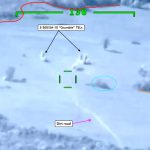Iran launched a missile attack on Coalition facilities in Iraq as retaliation for the United States UAV-strike that killed IRGC-QF Maj. Gen. Qassim Soleimani.
SITUATION REPORT
- At approx. 1.30 (Baghdad time), the IRGC-Aerospace Force (IRGC-AF) launched 15 short-range ballistic missiles (SRBM) from Khermanshah (Iran) against Ain Al-Assad AB and Erbil AB in Iraq.
- Ten SRBMs targeted Ain Al-Assad AB and five Erbil AB (which also hosts Italian, British and German forces). However, four SRBMs malfunctioned on their way to Erbil and failed. At least one SRBM was reportedly intercepted by a US C-RAM system at Ain Al-Assad. FYI: There are no THAAD nor Patriot air defense systems deployed in Iraq.
- Judging by the engagement range and operational history, the IRGC-AF likely fired Qi’am-1 or Fateh-class SRBMs (e.g. Fateh-313).
- No known casualties resulted from the strike, but the US Department of Defense and the Iraqi Security Forces are still in the process of conducting a battle damage assessment.

Preliminary determination of the IRGC-AF’s SRBMs’ flight path from Iran to their targets in Iraq via T-Intelligence
- Unconfirmed reports indicate that inbound missile warnings were issued, allowing Iraqi and Coalition forces to take shelter in bunkers. This means that the SRBM launches were detected by US early warning assets such as aerial platforms, satellites or ground-based radars. All US bases in the region and joint Coalition-Iraqi facilities in Iraq have been on high alert since early January.
- Iran has officially claimed the attack. The Iranian Foreign Minister Javad Zarif, called the attack “proportional”. Follow-up strikes are not expected.
- The direct Iranian SRBM attack on Coalition forces is unprecedented, although very ineffective. If the DOD’s BDA proves that there are no human or major infrastructure losses, the chance of a US response are low. Both the US and Iran are interested in de-escalating the confrontation without losing face.
PRELIMINARY-BATTLE DAMAGE ASSESSMENT
This section will be updated when new information becomes available.
ANALYSIS
We assess with a high degree of confidence that the IRGC’s SRBM salvo at targets in Iraq was ineffective due to technological malfunction and careful pre-planning to mitigate US/Coalition losses. By mounting a major but non-lethal attack, the IRGC hoped “to kill two birds with one stone:”
- High internal expectations. The IRGC satisfied Iran’s internal thirst to avenge the death of Iran’s “national treasure” Maj. Gen. Qassim Soleimani and claim success. The IRGC claims it killed “80 Americans and destroyer several aircraft.”
- Controlled escalation. The IRGC hopes to dissuade U.S. President Trump from ordering counter-attacks that could lead to an open armed conflict.
The IRGC’s plan should work, in theory. We know that for the past few days, the United States Department of State was engaged in back-channel negotiations with Iran via Qatar, the Swiss Embassy in Tehran and Oman. Washington’s message was clear: “we expect a retaliation from you but it must be proportionate. American losses are off-limits and will trigger additional air strikes.” Washington enforced its threat with the swift deployment of 6,000 forces (consisting of paratroopers, marines and special forces) to the Middle East for contingency operations.
It seems that Iran obeyed the “rules of the game.” Iraq’s “care-taker” Prime Minister claims that Tehran notified him before the strike and then he notified the U.S, therefore helping the Coalition prepare for the “missile rain”. Despite Tehran’s efforts to craft a balanced aggression, the IRGC’s attack was unprecedented as it directly targeted a site housing US forces and used BMs. Tehran threaded carefully but still walked a thin line.
While impossible to predict President Trump’s next step, the chances of a U.S. military counter-strike have significantly decreased due to the lack of human losses. If Washington greenlights another strike, it will very likely target BM launchers, SAM systems and Command & Control (C2) nodes in western Iran. The objective of a new military attack would be to reduce the IRGC’s capability to plan, mount and execute BM attacks and “knock-off the door” (destruction/ suppression of enemy air defense systems) for follow-up air strikes, if required. The hypothetical scenario will likely lead to an low-intensity open conflict, restricted to air-naval engagements, between the two parties. However, there is no indication at this time suggesting that the U.S. President will follow an escalatory course of action.
- Russia Bombs Maternity Ward & Children’s Hospital in Mariupol As Part of Siege - 10 March 2022
- T-Intell’s OSINT Training Marks One Year Anniversary - 18 November 2021
- Russian Pipe-Layer Resumes Work on Nord Stream 2 - 25 January 2021





